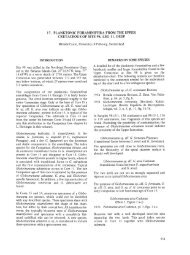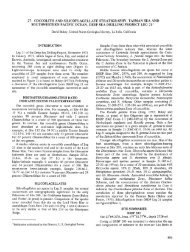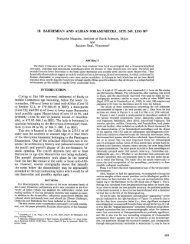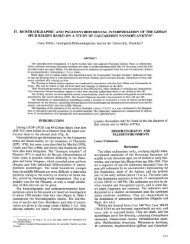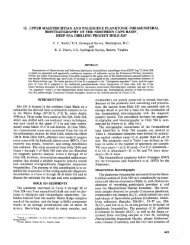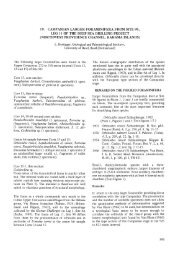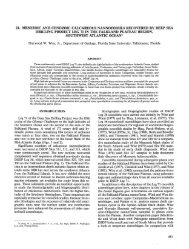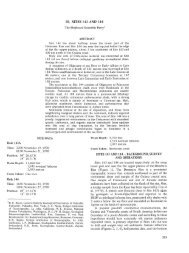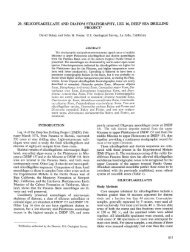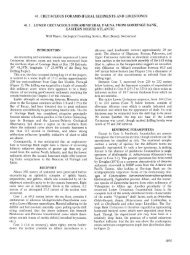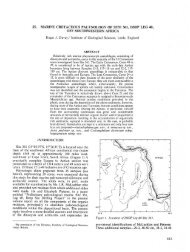16. Radiolaria - Deep Sea Drilling Project
16. Radiolaria - Deep Sea Drilling Project
16. Radiolaria - Deep Sea Drilling Project
You also want an ePaper? Increase the reach of your titles
YUMPU automatically turns print PDFs into web optimized ePapers that Google loves.
M. G. PETRUSHEVSKAYA, G. E. KOZLOVA<br />
Theocampe mongolfieri (Ehrenberg) group<br />
(Plate 23, Figures 3-5)<br />
Eucyrtidium mongolfieri Ehrenberg, 1854, pi. 36, fig. 18B; 1873, p.<br />
230; 1875, pi. 10, fig. 3.<br />
Theocampe mongolfieri (Ehrenberg), Burma 1959, p. 239; Riedel<br />
and Sanfilippo, p. 536; Riedel and Sanfilippo, in press, pi. 3E,<br />
fig. 13.<br />
ISethamphora costata Haeckel, 1887, p. 1251, pi. 62, fig. 3.<br />
IDictyocephalus pulcherrimus typ. Clark and Campbell, 1942, p.<br />
78, pi. 8, fig. 2.<br />
Eocene.<br />
Theocampe excellens (Ehrenberg)<br />
(Plate 23, Figure 7)<br />
Eucyrtidium exellens Ehrenberg, 1873, p. 228; 1875, pi. 10, fig. 12.<br />
Differs from T. mongolfieri by its smaller pores on the abdomen.<br />
These pores are not disposed in distinct longitudinal rows.<br />
Oligocene.<br />
Subgenus TRICOLOCAMPE Haeckel<br />
Tricolocampe Haeckel, 1881, p. 434; 1887, p. 1411 ;ROH Campbell,<br />
1954, p. 134; Petrushevskaya, 1971b, p. 198. = Tricolocampium<br />
Haeckel, p. 1412. Type species Tricolocampe cylindrica Haeckel<br />
(1887, pi. 66, fig. 21).<br />
The shelf between thorax and abdomen may be more or less<br />
pronounced. Abdomen is slender, ovate. It is somewhat broader<br />
than the thorax in its upper part. In fully developed specimens the<br />
mouth is constricted and even elongated into a short tube, but very<br />
often the skeleton is incomplete. Abdomen is flattened laterally.<br />
The pores on the abdomen are disposed in horizontal (transverse)<br />
rows-as in typical artostrobiids.<br />
Cretaceous-Recent.<br />
The species T. vanderhoofi Campbell and Clark, Theocampe lispa<br />
Foreman, T. altamonensis (Campbell and Clark) and T. dactylica<br />
Foreman (described by H. Foreman (1968) seem to belong in this<br />
group.<br />
This group is more closely related to Theocampe subgenus I than<br />
to typical Theocampe.<br />
Theocampe sp. aff. T. gemmata (Ehrenberg)<br />
(Plate 23 Figure 10)<br />
lEucyrtidium gemmatum Ehrenberg, 1873, p. 229; 1875, pi. 10,<br />
fig. 6.<br />
This species differs from T. gemmata by the outline of the test.<br />
It is somewhat similar to the species described as Theocorys ovata<br />
Haeckel, 1887, pi. 69, fig. 16, but differs from it by the smaller<br />
number of the pores in a horizontal row and by the deeper<br />
constriction between thorax and abdomen.<br />
Eocene.<br />
Theocampe callimorphos (Clark and Campbell)<br />
(Plate 23, Figure 8)<br />
Dictyocephalis callimorphos Clark and Campbell, 1945, p. 42, pi. 6,<br />
fig. 7.<br />
Lithomitra sp. aff. Lithomitra lineata (Ehr.) Riedel and Sanfilippo,<br />
in press, pi. 3E, figs. 17, 18, part.<br />
This form has longitudinal furrows between the pores of a<br />
horizontal row.<br />
Eocene.<br />
Theocampe eos (Clark and Campbell)<br />
(Plate 23, Figure 9)<br />
Dictyocephalus eos Clark and Campbell, 1945, p. 42, pi. 6, fig. 8.<br />
Very much the same as T. callimorphos, but without longitudinal<br />
furrows.<br />
Eocene.<br />
Subfamüy ARTOSTROBIINAE Riedel<br />
Artostrobiidae Riedel, 1967a, p. 149; 1967b, p. 296; Petrushevskaya,<br />
1971a, p. 985;1971b,p.235.<br />
Four- or multi-segmented Artostrobiidae. Pores are disposed on<br />
the abdomen in distinct transverse (horizontal) rows.<br />
538<br />
Genus THEOCAMPTRA Haeckel, emend, Petrushevskaya<br />
Theocamptra Haeckel, 1887, p. 1424; Campbell, 1954, p. 134. Type<br />
species Theocampe collaris Haeckel, 1887, pi. 66, fig. 18.<br />
After the cephalis, which is united with thorax, the third<br />
segment (distinctly separated from the other part of the skeleton) is<br />
distinguished. The third segment is rather short, nearly of the same<br />
length as the thorax. The lower part of the test is very much like the<br />
abdomen of Theocampe species, and the third segment seems to be<br />
inserted between thorax and abdomen. This is the only difference<br />
between Theocamptra and Theocampe {Tricolocampe).<br />
Paleogene-Neogene.<br />
Theocamptra marylandica (Martin)<br />
(Plate 23, Figures 20, 21)<br />
Lithocampe marylandica Martin, 1904, p. 450, pi. 130, fig. 4.<br />
Three transverse rows of pores on the third segment. The fourth<br />
segment up to 90-100µ broad.<br />
Miocene.<br />
Theocamptra sp. aff. T. marylandica<br />
(Plate 23, Figures 22, 23)<br />
ILithocampe marylandica Martin, 1904, p. 450.<br />
Artostrobium sp. aff. A. doliolum Riedel and Sanfilippo, in press,<br />
pi. 21, fig. 4.<br />
Differs from the typical T. marylandica by its smaller<br />
dimensions; the fourth segment up to 60-70µ broad.<br />
Miocene.<br />
Remark: Both species are very similar to Theocampe callimorphos<br />
(Clark and Campbell) (PL 23, fig. 8). The difference lies in the<br />
segmentation of the test.<br />
Theocamptra ovata (Haeckel)<br />
(Plate 23, Figures 17-19)<br />
Lithocampe ovata Haeckel, 1887, p. 1504, p. 77, fig. 1.<br />
Two transverse rows of pores on the third segment. No furrows<br />
near the pores on the fourth segment.<br />
Miocene.<br />
Theocamptra sp. aff. Theocamptra ovata (Haeckel)<br />
(Plate 23, Figures 15, 16; Plate 24, Figure 6)<br />
Very much the same as typical T. ovata, but has longitudinal<br />
furrows between the pores. This feature makes this species similar to<br />
Theocamptra aff. marylandica and to Theocampe callimorphus.<br />
Oligocene.<br />
Theocamptra collaris (Haeckel)<br />
Theocampe collaris Haeckel, 1887, p. 1425, pi. 66, fig. 18.<br />
Artostrobium sp. aff. A. doliolum Riedel and Sanfilippo, in press,<br />
pi. 21, figs. 1, 3, 5, part.<br />
One transverse row of pores on the third segment. The fourth<br />
segment is 1.5 times broader than the third (the same as in T.<br />
marylandica group and in T. ovata group).<br />
Miocene.<br />
Theocamptra corona (Haeckel) group<br />
(Plate 23, Figures 24, 25)<br />
Cyrtophormis corona Haeckel, 1887, p. 1462, pi. 77, fig. 15.<br />
Phormostichoartus corona (Haeckel) Riedel and Sanfilippo, in press,<br />
pi. 2J, figs. 1-5.<br />
Four transverse rows of pores on the third segment. It is<br />
distinguished from T. collaris, T. marylandica and T. ovata also by<br />
the comparative breadth of the fourth segment. In T. corona the<br />
fourth segment is 2 to 2.5 times broader than the third segment.<br />
Miocene.<br />
Theocamptra spirocyrtis Petrushevskaya sp. nov.<br />
(Plate 23, Figures 28-30)<br />
The description is based on 21 specimens from 139-5-CC;<br />
140-2-1, 5-7 cm and 80-82 cm; 140-2-3, 80-84 cm and 140-2-4, 5-7<br />
cm and 80-82 cm.<br />
Seven to nine transverse rows of pores on the third segment,<br />
which is about 60µ long. It is broader in its lower part (about<br />
60-80µ) than in its upper part. The fourth segment 2 to 2.5 times as<br />
broad as the third. Very often the large and thin-walled fourth<br />
segment is damaged.<br />
Miocene.



